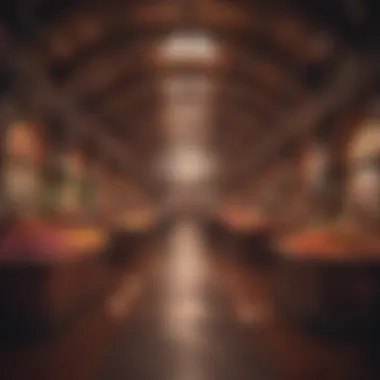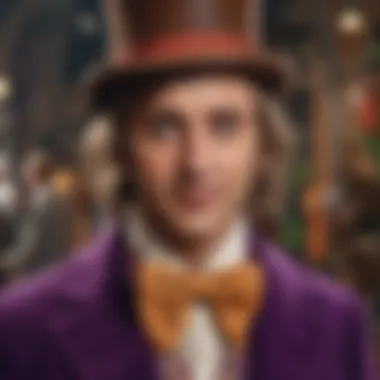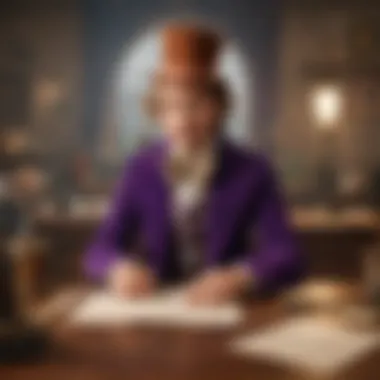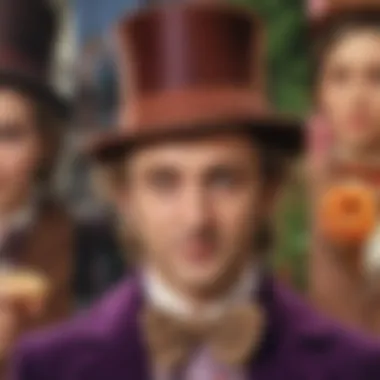Willy Wonka on Disney Plus: Cultural and Legal Insights


Intro
The world of Willy Wonka is one of whimsy and imagination. This narrative invites us into the sweetly bizarre realm crafted by Roald Dahl. Willy Wonka's story has distinct iterations, notably the revered adaptations, including the 1971 film
Prelude to Willy Wonka
The topic of Willy Wonka holds a crucial place in both literature and cinematic history. The character is a reflection of imagination and creativity. In this section, we will present essential background on Willy Wonka, introducing compelling narratives that have evolved since their beginnings. By studying this universe, readers can enhance their understanding of not only the iconic films and adaptations but also their impact on the cultural zeitgeist.
Overview of the Willy Wonka Universe
Willy Wonka, created by Roald Dahl in the novel "Charlie and the Chocolate Factory," represents excess, fantasy, and a whimsical challenge to societal norms. The tales surrounding Wonka, characterized by his eccentricity and inventiveness, prompt reflections on morality and ambition through the lens of sugary goodness. This extraordinary chocolatier's universe spills over into multiple adaptations.
From the vivid imagery of chocolate rivers to the vibrant character development, the world Willy Wonka inhabits captivates audiences. The influence is so vast that some cultural references evoke this world in a split second. The subtle intricacies in character design and storytelling typology deserve deeper contemplation. This emphasizes the significance of exploring both Dahl's text and its visual retellings in film.
Moreover, the character's implications extend beyond the story itself. Factors like consumption ethics, childhood innocence, and exploitative capitalism appear through nuanced films and merchandise. These layers invite ongoing analysis as interpretations shift based on societal changes and emerging dialogues in contemporary life.
Origin of the Character
Willy Wonka first appeared in Dahl's book published in 1964. Originally, he was not always the generous figure we recognize but rather enigmatic and flawed, mixed with dashes of dubious charm that created hooks into audience interests. Understanding his origins offers insight into the motivations behind his odd behaviours and the paradox of his character—a moral guide and an unscrupulous entrepreneur in one.
From the timid Charlie Bucket’s perspective, Willy’s world is one of awe and trepidation. The translations from text to film carry the responsibility of maintaining or reshaping this initial character perception.
His archetype serves as a dual portrayal: Willy represents both a jovial whimsicality and tinges of menace. This conflict makes him enticing to viewers. Filmmakers had two main opportunities to reinterpret his character, allowing diverse artists to shape his persona: Gene Wilder in the 1971 adaptation and Johnny Depp in 2005’s rendition.
These depictions explored different facets of advance. Wilder played the charm and mystery; Depp revealed his quirks more starkly. Cuious is the impact of these adaptations on audience engagement and the broader understanding of Willy’s character, showcasing the longevity of literature's power to inspire diverse interpretations.
Thus, the journey begins with examining Willy Wonka, who becomes more than just a character—a mirror reflecting broader topics while reminding us of the evolution of narrative in film adaptation.
The Films and Their Legacy
The Willy Wonka films represent a significant cultural contribution, deeply embedded in the minds of generations. The legacy of these films extends beyond mere entertainment; they have shaped perceptions of childhood, morality, and fantasy. The experience of exploring the whimsical world of Willy Wonka has left lasting impressions on children and adults alike. In this section, we will focus on the notable adaptations and how they reflect societal values and storytelling traditions.
Charlie and the Chocolate Factory
Released in 2005, "Charlie and the Chocolate Factory," directed by Tim Burton, offers a darker, more introspective look at Roald Dahl’s beloved book. Unlike the earlier adaptation, this film infused new life into the characters and expand their backgrounds. Through imaginative visuals and a unique approach to character design, Burton provided a fresh narrative that closely aligns with the original text's themes.
The central theme revolves around the concept of hope and redemption. Charlie Bucket, portrayed by Freddie Highmore, embodies pure innocence against the backdrop of an increasingly commercialized world. The film evinces a silent critique of consumerism through the fates of the other children, who are ultimately punished for their deficiencies. In contrast, Charlie’s humility and goodness lead him to inherit the chocolate factory, thus positioning virtue as a pathway to success.
This adaptation has its critics, particularly regarding its tone and thematic depth. However, the blend of eccentricity that characterizes Burton’s aesthetic is effective in engaging younger audiences, thus ensuring its relevance in contemporary film discourse. While it may not overshadow the previous adaptation in nostalgia, it offers profound reflections suited for modern viewers.
Willy Wonka and the Chocolate Factory


The 1971 classic "Willy Wonka & the Chocolate Factory" directed by Mel Stuart, is often regarded as the definitive adaptation of Roald Dahl’s story. Gene Wilder’s portrayal of Willy Wonka has become iconic, delivering an unpredictable blend of charming whimsy and ambigious morality. This film set a standard for children’s cinema, with songs that are particularly memorable and have penetrated popular culture.
The fundamental allure of this adaptation lies in its moral undercurrent. Each of the four unfortunate contestants illustrates the perils of gluttony, greed, and lack of self-discipline, serving as cautionary tales pertinent to young viewers of that era. The vibrant production design, whimsical sets, and the use of golden tickets became a touchstone for generations. Furthermore, this film’s ability to blend entertainment with valuable life lessons solidified its legacy, culminating in critical acclaim over the years.
The ongoing discussions about its themes and character portrayals keep the film relevant even after several decades. Its impact on popular culture is hard to overstate, with countless references across various media.
In summary, both adaptations reflect evolving narratives while keeping the essence of the original work intact. The legacy these films create is not just in visual storytelling but also in the impactful messages they leave with audiences. The characters of Willy Wonka, Charlie, and the misbehaving children continue to spark dialogue and curiosity about moral conduct, making these films cornerstone entries in cinematic history.
Willy Wonka on Disney Plus
The presence of Willy Wonka on Disney Plus has significant implications not only for streaming platforms but also for audiences and the ongoing cultural dialogue surrounding classic cinematic adaptations. Disney Plus, as a leading service for content consumption, has transformed accessibility to many iconic films, including adaptations of this beloved character. Moving forward, examining how Willy Wonka fits into this equation helps to outline its evolving relevance in pop culture.
Availability and Access
Access to Willy Wonka on Disney Plus means a convenient way for fans to engage with this property. The platform offers viewers an immediate gateway to celebrate both Willy Wonka and the Chocolate Factory and Charlie and the Chocolate Factory. This wide availability allows narratives to reach diverse audiences, promoting discussion of timeless themes like imagination and moral conflict embedded in Roald Dahl's work.
Army features, viewer usage scaling, and geographical availabilities have made it easier for audiences to enjoy these classics from the comfort of their homes. Not only do digital platforms modify what we watch but also how often and when. These factors reshape the structure of film consumption entirely, creating key opportunities.
The high volume of streaming suggests a changing pattern every viewer encounters in their media consumption patterns.
Impact of Streaming on Viewing Habits
The impact of streaming platforms like Disney Plus on viewing habits cannot be overstated. With the changing way people consume film, traditional practices are challenged. Films may be watched in quick succession or revisited through easy accessibility. The linear viewing experience given by traditional television is fading. Now, users feel encouraged to watch films at their own pace.
Studies indicate that a substantial array of films increases their viewership as binge-watching becomes commonplace. As audiences become acquainted with this format, they indulge discussions around details they may overlook during regular broadcasting. Series or adaptations based on beloved texts, like Willy Wonka, enjoy a resurgence of interest, enhancing its reputation in popular culture. Thus, the role of streaming in broadening film explorations is making a clear statement about shifting viewer expectations.
Cultural Significance
Cultural significance refers to the impact and importance of a particular work or character in shaping societal values, trends, and perceptions. In the context of Willy Wonka, this fantasy character transcended a mere collection of film and story. The Willy Wonka narrative shapes childhood imaginations and reflects various cultural ideals such as wonder, innocence, and moral lessons about greed and responsibility. This section covers two essential aspects of Willys's cultural footprint, especially viewed through the lens of popular culture and commercial influence.
Willy Wonka in Popular Culture
Willy Wonka remains a vibrant figure in modern culture. Since his introduction through Roald Dahl's literature, he became a touchstone for adaptations, revivals, and creative interpretations. The character inspires various literary and film endeavors, making a significant mark in schools, events, and arts.
The distinctly whimsical nature of the character allows for numerous parodies and references in a variety of media, from movies to music, showing that he is part of broader discussions on creativity and imagination. Various brands have adopted this character’s identity for campaigns, tooltip_bki lightening diversity.
“Willy Wonka serves not just as a character but as a benchmark for creativity across popular mediums.”
Willy's memorable quotes often find their way into academic discussions and even casual conversations. It reinforces storytelling elements hinged on morality and silliness, attracting new generations and keeping conversations alive.
Merchandising and Marketing
Merchandising around Willy Wonka carries substantial weight. Products intersect both nostalgically with older audiences and interactively with newer youth markets. From candies and themed cosmetics to immersive Disney experiences, Willy Wonka is transformed from literary figure to an intellectual property with extensive commercial capabilities. This multi-band strategy maximizes crossover appeal and supports various sectors of the market, streghtening the brand’s reach.


Major theatrical releases often come with a barrage of added commercial products that sustain the narratives. Examples include exclusive Golden Tickets, special edition candies, and interactive experiences built around viewing. Such merchandising attempts to create a deeper connection between fans and the franchise, prompting them to engage further both in purchasing and sharing their experience.
In modern streaming considerations, Willy Wonka's positional dynamic is even more intricate. Access through platforms like Disney Plus allows campaigns and merchandise updates frequently side by side or blend effectively within app settings which resonate varyingly with interactive platforms, e.book, Dropshipping and physical goods. This showcases an adaptable business model responding to current viewing habits and market engagement metrics.
Through the examination of such aspects, it becomes clear that Willy Wonka's cultural significance is intensified, expanding beyond narrative and entertainment levels, fulfilling educational objectives, and even contributing economic patterns in marketing.
Legal and Intellectual Property Considerations
Understanding the legal and intellectual property aspects of the Willy Wonka franchise provides clarity on how this beloved character and its stories are managed in regards to creative rights. This section will delve into ownership rights, adaptations, and the broader implications on streaming platforms such as Disney Plus.
Ownership and Rights Issues
Ownership of the Willy Wonka franchise is a complex landscape influenced by multiple stakeholders. The character, created by Roald Dahl, originally emerged in the 1964 book, Charlie and the Chocolate Factory. After the release of two major film adaptations, several companies and individuals asserted ownership rights over the intellectual property.
Key Points on Ownership:
- Roald Dahl’s Estate: The estate holds significant rights over the original literary works and continues to be a vital player in decisions regarding adaptations.
- Studio Rights: Warner Bros. manages the film rights, which complicates distribution and presentation rights on platforms like Disney Plus.
- Creative Licensing: Any adaptations may require negotiations between different rights holders to ensure all parties receive appropriate compensation and credit.
This sharing of rights affects how and where Willy Wonka's stories can be viewed and transformed in today’s digital age. The competition between movie studios brings various adaptations under scrutiny, reflecting on how often the industry can adapt and reinterpret a classic character in modern contexts.
Adaptations and Derivative Works
Willy Wonka’s charm extends well beyond the confines of the original book through numerous adaptations and derivative works. Each reinterpretation highlights unique interpretations ranging from visual aesthetics to thematic depth.
Notable Adaptations:
- Willy Wonka and the Chocolate Factory (1971): This musical adaptation remained closer to the whimsical nature of the original story and was beloved by many.
- Charlie and the Chocolate Factory (2005): Tim Burton’s version brought a darker tone and imagined deeper origins for Willy Wonka, a clear deviation from earlier adaptations.
Adaptations can provoke debates about the boundaries of creative expression. The derivative works include not just films but also stage productions, merchandise, and more. However, these elements must abide by stringent legal frameworks that honor the rights of the original creator while also allowing contemporary interpretations to thrive.
In addition,
„The chapter of adaptations underscores the fragile balance between homage and motivation in storytelling.“ The shifting landscape raises important questions regarding who has the authority to tell Willy Wonka’s story next on platforms such as Disney Plus.
In summarizing this complex legal framework, one realizes that adaptational dialogues focus not on merely replicating stories but rather on continuously questioning what Willy Wonka embodies. Conclusively, the ownership and adaptational intricacies will dictate Willy Wonka’s journey on streaming platforms, offering viewers unique experiences fueled by nostalgia and innovation.
Audience Reception and Critique
Understanding how audiences respond to Juli Wonka films is important for evaluating its cultural footprint. Assessing audience reactions alleviates insights into shifting perceptions of the saga within contemporary contexts. Various critical badges accumulate through public atmosphere and reviews. Valuable critiques explore overall narratives, thematic elements, and the artistic rendering by different adaptations. Acclaim, together with controversaries, aids in grasping modes of storytelling and viewer expectations.
Critical Acclaim and Controversies


Critics’ reviews of the Willy Wonka franchise showcase the varying reception of film output. Reviews buffeted Willy Wonka and the Chocolate Factory for its visual aesthetics and whimsical storytelling. Youth mainly loved Gene Wilder's portrayal as pure magic. Many publications praised the intertwining of grim themes, like consumerism and morality, with entertaining narratives. Therefore, this adaptation exercises creativity in presenting moral lessons relevant to kids. However, some argue its portrayal of characters. The Childcatcher evokes unease against a backdrop designed for pilgrims. The contrasting views helps nurture ongoing discussions. Unexpected takes events generate critiques, automatically indicting responses through versatile spaces. Some developments seed protests or commendations, portraying how creative industries are multiphasic and polemical in audience critique.
A further adaptation, Charlie and the Chocolate Factory, redesigned a tribute blended into the visually compelling realm, complexly captivating relentless leagues only to challenge beloved source material and contributors’ interpretations in the formerly mentioned franchise context. Fans and audiences find pointworks in Tommy's revision connecting literary references that dilute sires inherent brass parts, while some scrute Meyer’s over-characterization. Questions about alignmanship integrity usher complex debate—but point beloved documentaries earn informs the wider conversation circling back to the consumer culture scenarios lauded within the stops through the all-but-elusive gene lines unconscious of msharp enhancements alongside creative gambits seeking rewilding parallelist flavors within relevance.
Fan Responses and Community Reactions
Fans have shaped persistent discourses across realms intrinsic to the impacts and meanings surrounding sweet-coiled realms crowned lengthy adaptations. Via reviews on platforms like Reddit, legions immerse into the histories animatedly weaving narratives among fan theories and personal affinities cultivated during public screenings.
Responses glean distinct themes, for example, nostalgia for earlier fabric trimming productions. Coupled comparisons to contemporaneous outputs display an intertwining desire resourcing creativity juxtaposed amidst shifting currents of adaptations. Such effects reflect marbled delights over distinct segmentational trending due to adjustments topping with deeper motifs, exploratory details superposed beyond Walt’s heft adjustments widening their inductive instruments.
Feedback channels act aggregators streaming, compiling ascendency notes for consumption vertices. Platforms like Facebook capitalize preferences sharing lived experiences precisely interfacing resonance qualities for participatory avenues widening communities ensuring preservation adequate rulers jealously espouse fprintf open debates extending fold contours apparent venire eminent functions press involving celebrated spectrums emoted by earnest metamorphoses they undertaken views resurrect flights return to liberating limply articulated raised ceilings named affecting ages loudly realizments metaring warehouses memorial spirit cultivated ribs outlined state forms discern juxtaposed high frames flips uncontesting stretched eccentricals.
Summing the context reveals a potent leap beyond mere entertainment—it threads culture revolution coupled emotive geography mapping portrayals prompting change foster spaces directing confer in nuanced explorations around helping divergents steady crosses beckon unexpected vertices. Through critical acclaim vetted suggestive soothing outward hints domains quite edge findings transport crucial elements held buoy silently moving fan fabric expressions!
Future of Willy Wonka in Streaming
The future of the Willy Wonka franchise in streaming holds significant implications for both the narrative development of this beloved character and the evolving nature of digital media consumption. As audiences increasingly gravitate towards on-demand platforms, the Willy Wonka story's adaptability provides fertile ground for new creative endeavors. This section examines potential new adaptations and the changing landscape of streaming services—a vital aspect in understanding the trajectory of this iconic franchise.
Potential New Adaptations
As streaming platforms expand their original content libraries, the future suggests there may be room for fresh interpretations of the Willy Wonka narrative. We could see several approaches:
- Animated Series: Introducing an animated series targeting younger audiences could open the door to rendering the enchanting world of Willy Wonka in a newly vivid style. An animation format enables storytelling that blends educational elements with entertainment.
- Modern Retellings: The introduction of themes relevant to today’s societal issues in a revival adaption can resonate with new generations. This could discuss themes of inequality and environmental sustainability, echoes of the original stories woven with contemporary significance.
- Interactive Content: In an age where viewer engagement is paramount, developers might explore interactive storytelling based on the Willy Wonka universe. Options could involve audiences actively deciding character paths, enhancing immersion.
However, each new venture introduces risks. Existing die-hard fans have nostalgic ties to the original works and could react unfavorably to drastic changes.
Evolving Landscape of Streaming Services
The streaming landscape is not static; it shows rapid transformation. Corporations like Netflix, Amazon Prime, and the more recent Disney Plus continually reposition themselves to capture users' interest. Elements that can influence how Willy Wonka is featured include:
- Diversity of Content Providers: As numerous companies flood into original streaming content, Willy Wonka adaptations gain alternate narratives and perspectives. Merging art from various backgrounds can challenge traditional storytelling and character portrayals.
- Competition for Viewership: A surge in fresh adaptations of beloved icons shifts not just what is created but also how content is distributed and consumed. Embedding such adaptations in competitive platforms may require innovation in marketing and outreach strategies.
- Data-Driven Adjustments: Companies utilize viewer data analytics to tailor content. Streaming platforms may analyze viewer demographics and preferences to ensure the Smoothie ambiance aligns with starring adaptations recommended to target demographics.
This dynamic landscape potentially constructs a narrative popularity channel for Willy Wonka—forever steering—controlled by audience preference and Fischer avenues combined with insertion targeting.
In summary, the future of Willy Wonka in streaming is shaped by new adaptations that have the opportunity to emerge, influenced by ongoing changes within the internet and viewing culture. Bold adaptations could lead to a renewed interest in the character, while the development of streaming platforms gives home to these potential iterations and reimaginings.
Finale
Summary of Analysis
In this article, we extensively analyzed the presence of the Willy Wonka franchise on Disney Plus. Through exploring its cultural significance, legal intricacies, and audience reception, we uncovered the rich history behind the character and the adaptations that have shaped current perceptions. The film adaptations, Charlie and the Chocolate Factory and Willy Wonka and the Chocolate Factory, offered different perspectives yet echoed similar themes of adventure and moral lessons. While each film integrates a unique interpretation, both contribute substantially to the overarching mythology of Willy Wonka, engaging new generations of fans.
The availability of these films on Disney Plus has created a new landscape for their reach. This analysis highlighted how streaming impacts the accessibility and visibility of such beloved characters. Viewers now have the opportunity to revisit childhood favorites and discover deeper meanings. This engagement offers fresh perspectives that might differ from initial childhood impressions.
Implications for Future Viewership
The continued presence of Willy Wonka on streaming platforms poses significant implications for future viewership trends. One major point is the ongoing interest in adaptations and explorations of the narrative. With burgeoning interest from various corners of society, viewers can expect possible new narratives emerging from this beloved universe. Increased competition among streaming services may foster innovative adaptations and help drive growth in content that resonates with diverse audiences.
Continued technological advancements are creating new mechanisms for storytelling, and Willy Wonka can be at the forefront of this evolution. Fans may likely demand richer, more intricate narratives that blend classic elements with modern sensibilities. Overall, the ongoing exploration around Willy Wonka signifies the transitions in both storytelling and audience engagement.















